
Nuclear warfare, also known as atomic warfare, is a theoretical military conflict or prepared political strategy that deploys nuclear weaponry. Nuclear weapons are weapons of mass destruction; in contrast to conventional warfare, nuclear warfare can produce destruction in a much shorter time and can have a long-lasting radiological result. A major nuclear exchange would likely have long-term effects, primarily from the fallout released, and could also lead to secondary effects, such as "nuclear winter", nuclear famine and societal collapse. A global thermonuclear war with Cold War-era stockpiles, or even with the current smaller stockpiles, may lead to various scenarios including the extinction of the human species.

World War III or the Third World War, often abbreviated as WWIII or WW3, are names given to a hypothetical worldwide large-scale military conflict subsequent to World War I and World War II. The term has been in use since at least as early as 1941. Some apply it loosely to limited or more minor conflicts such as the Cold War or the war on terror. In contrast, others assume that such a conflict would surpass prior world wars in both scope and destructive impact.

Charles Erwin Wilson was an American engineer and businessman who served as United States Secretary of Defense from 1953 to 1957 under President Dwight D. Eisenhower. Known as "Engine Charlie", he was previously the president and chief executive officer of General Motors. In the wake of the Korean War, he cut the defense budget significantly.
AirLand Battle was the overall conceptual framework that formed the basis of the US Army's European warfighting doctrine from 1982 into the late 1990s. AirLand Battle emphasized close coordination between land forces acting as an aggressively maneuvering defense, and air forces attacking rear-echelon forces feeding those front line enemy forces. AirLand Battle replaced 1976's "Active Defense" doctrine, and was itself replaced by "Full Spectrum Operations" in 2001.

The Single Integrated Operational Plan (SIOP) was the United States' general plan for nuclear war from 1961 to 2003. The SIOP gave the President of the United States a range of targeting options, and described launch procedures and target sets against which nuclear weapons would be launched. The plan integrated the capabilities of the nuclear triad of strategic bombers, land-based intercontinental ballistic missiles (ICBM), and sea-based submarine-launched ballistic missiles (SLBM). The SIOP was a highly classified document, and was one of the most secret and sensitive issues in U.S. national security policy.

The German Air Force is the aerial warfare branch of the Bundeswehr, the armed forces of Germany. The German Air Force was founded in 1956 during the era of the Cold War as the aerial warfare branch of the armed forces of then West Germany. After the reunification of West and East Germany in 1990, it integrated parts of the air force of the former German Democratic Republic, which itself had been founded in 1956 as part of the National People's Army. There is no organizational continuity between the current German Air Force and the former Luftwaffe of the Wehrmacht founded in 1935, which was completely disbanded in 1945/46 after World War II. The term Luftwaffe that is used for both the historic and the current German air force is the German-language generic designation of any air force.
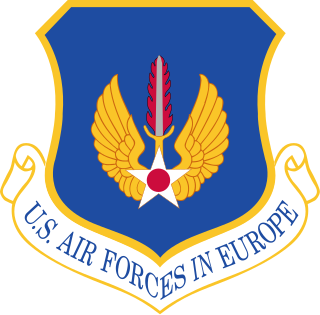
The United States Air Forces in Europe – Air Forces Africa (USAFE-AFAFRICA) is a United States Air Force (USAF) major command (MAJCOM) and a component command of both United States European Command (USEUCOM) and United States Africa Command (USAFRICOM). As part of its mission, USAFE-AFAFRICA commands U.S. Air Force units pledged to NATO, maintaining combat-ready wings based from the United Kingdom to Turkey. USAFE-AFAFRICA plans, conducts, controls, coordinates and supports air and space operations in Europe, parts of Asia and all of Africa with the exception of Egypt to achieve U.S. national and NATO objectives based on taskings by the two combatant commanders.

Robert Charlwood Richardson III was an American military officer of the United States Army Air Corps, and subsequently the United States Air Force, eventually attaining the rank of brigadier general. A leader in the early days of the US Air Force, he was a renowned expert in tactical nuclear warfare, NATO, and military long range planning.

A military exercise, training exercise, or war game is the employment of military resources in training for military operations. Military exercises are conducted to explore the effects of warfare or test tactics and strategies without actual combat. They also ensure the combat readiness of garrisoned or deployable forces prior to deployment from a home base.

Exercise Red Flag is a two-week advanced aerial combat training exercise held several times a year by the United States Air Force. It aims to offer realistic air-combat training for military pilots and other flight crew members from the United States and allied countries.
Able Archer 83 was the annual NATO Able Archer exercise conducted in November 1983. The purpose for the command post exercise, like previous years, was to simulate a period of conflict escalation, culminating in the US military attaining a simulated DEFCON 1 coordinated nuclear attack. The five-day exercise, which involved NATO commands throughout Western Europe, was coordinated from the Supreme Headquarters Allied Powers Europe (SHAPE) headquarters in Casteau, Belgium.

Allied Joint Force CommandNaples is a NATO military command based in Lago Patria, in the Metropolitan City of Naples, Italy. It was activated on 15 March 2004, after effectively redesigning its predecessor command, Allied Forces Southern Europe (AFSOUTH), originally formed in 1951. In NATO Military Command Structure terms, AFSOUTH was a "Major Subordinate Command". The commander of JFC Naples reports to the Supreme Allied Commander Europe at the Supreme Headquarters Allied Powers Europe, Casteau, Belgium.

Weapons Storage and Security System (WS3) is a system including electronic controls and vaults built into the floors of Protective Aircraft Shelters (PAS) on several NATO military airfields all over the world. These vaults are used for safe special weapons storage, typically of tactical B61 nuclear bombs. Historically the system was also called within NATO the Weapon Security and Survivability System (WS3) or Weapons Survivability and Security System.
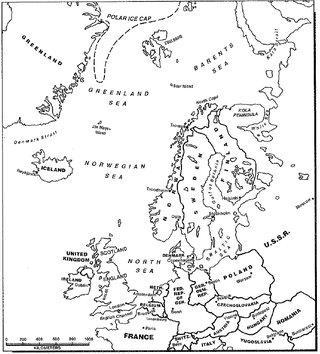
Exercise Mainbrace was the first large-scale naval exercise undertaken by the newly established Allied Command Atlantic (ACLANT), one of the two principal military commands of the North Atlantic Treaty Organization (NATO). It was part of a series of NATO exercises jointly commanded by Supreme Allied Commander Atlantic Admiral Lynde D. McCormick, USN, and Supreme Allied Commander Europe General Matthew B. Ridgeway, U.S. Army, during the fall of 1952.
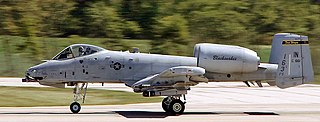
The 163rd Fighter Squadron is a unit of the Indiana Air National Guard's 122nd Fighter Wing, located at Fort Wayne Air National Guard Station, Indiana. The 163rd is equipped with the A-10 Thunderbolt II.
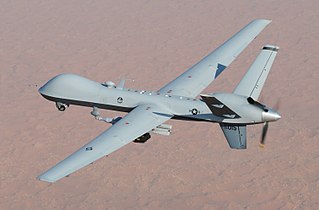
The 162nd Attack Squadron is a unit of the Ohio Air National Guard 178th Wing located at Springfield Air National Guard Base, Springfield, Ohio. The 162nd is equipped with the General Atomics MQ-9 Reaper UAV.
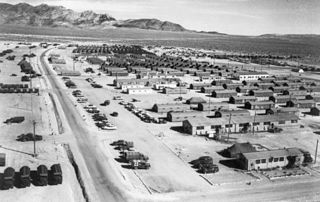
Desert Rock was the code name of a series of exercises conducted by the US military in conjunction with atmospheric nuclear tests. They were carried out at the Nevada Proving Grounds between 1951 and 1957.
Exercise Frisian Flag Is a major NATO multinational aerial exercise, held annually at Leeuwarden Air Base, Netherlands, over the North Sea and in the skies above the Netherlands, Germany and Denmark.















